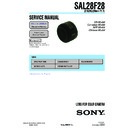Sony SAL28F28 Service Manual ▷ View online
4-10
SAL28F28 (2.8/28) (28mm F2.8)
2)
Attach the checking lens to the lens test projector, and set the equipments as shown in Fig.4-3-2.
3)
Turn the fan switch of the lens test projector to ON, then turn the lamp switch to ON.
Fig.4-3-2
4)
Turn the distance tube of the checking lens until the chart image projected on the screen is the sharpest at the center (y’=0).
5)
Set the plane mirror to the center of the projected image (y’= 0), and adjust the projector position so that the mirror reflects the light
to the center of the lens.
Distance
Lens test projector
Chart
Fan switch
Lamp switch
Plane mirror
Screen
A-mount attachment
Checking lens
F
L
4-11
SAL28F28 (2.8/28) (28mm F2.8)
2. Checking Method
1)
Turn the distance tube of the checking lens until the chart image projected on the screen is the sharpest at the center (y’=0).
2)
Read the number of the smallest pitched lines at the center (y’= 0).
Fig.4-3-3
3)
Turn the mount rotation ring of lens test projector until the projected image at a certain peripheral point (y’= 15) on the screen
appears the most unsharp.
Read the number of the smallest pitched lines (both saggital and meridional: 3 lines) at the peripheral point.
Note:
When reading the number of the smallest pitched lines, be careful of the spurious resolution.
Spurious resolution is the reversed image of 2 or 4 lines which appears on screen when focus is beyond maximum revolving
power.
Do not confuse spurious resolution for the smallest pitched lines.
Fig.4-3-4
4)
Check that the all readings (y’= 0, saggital (S) and meridional (M) at y’= 15) is within the specification of the Table 4-3-2.
When the specification is not satisfied, perform the following procedure.
• Replace the
front lens block
or
rear lens block
Specification
Focal-length distance (m)
Number of the smallest pitched lines
f (mm)
Center (y’=0)
y’= 15
(Lines per mm)
S
M
28
0.8 to 1.16
125 or greater
63 or greater
40 or greater
Table 4-3-2
5)
After the checking is completed, turn the lamp switch of the lens test projector to OFF and cool the inside of the lens test projector,
then turn the fan switch to OFF.
The number represents for lines per mm.
Saggital (S)
Meridional (M)
Correct resolution
Spurious resolution
Ver. 1.2 2007.10
The changed portions from
Ver. 1.1 are shown in blue.
Ver. 1.1 are shown in blue.
4-12
SAL28F28 (2.8/28) (28mm F2.8)
4-4.
FLANGE BACK (f’F) CHECK/ADJUSTMENT
4-4-1. Flange Back (f’F) Check
Equipment
• 1000 mm Collimator
• Flange Back Tester
• A-mount Attachment
• Flange Back Gauge (43.50mm)
1. Preparations
1)
Set the equipments as shown in the Fig.4-4-1.
Fig.4-4-1
2)
Looking through the eyepiece lens, turn the eyepiece ring of the flange back tester so that cross line or scale in the view is the sharpest.
3)
Attach the flange back gauge (43.50mm) securely to the A-mount attachment and hold them together.
4)
Turn the focusing knob of the flange back tester so that fine scratches on the flange back gauge (43.50mm) is the sharpest.
Note:
Turn the knob in the direction of the arrow of Fig.4-4-2 for correct reading.
Fig.4-4-2
5)
Turn the scale ring of the dial gauge until the long pointer indicates “0”.
Note:
This position is the flange back (f’F) = 43.5 mm.
Memorize the position of short-pointer.
flange back gauge (43.50mm)
A-mount attachment
Objective lens (10x)
Dial Gauge (Min. scale: 0.01 mm)
Scale ring
Eyepiece lens (7x)
Eyepiece ring
Focusing knob
Focus on fine lines on the surface.
Always turn the knob in the arrow
direction for correct reading.
direction for correct reading.
4-13
SAL28F28 (2.8/28) (28mm F2.8)
2. Checking Method
1)
Attach the checking lens to the flange back tester, and set the 1000 mm collimator.
Fig.4-4-3
2)
Set the distance tube of the checking lens to infinity end position while looking through the microscope, and align the optical axis to
the center of the chart image accurately.
3)
Turn the focusing knob of the tester until the chart image is the sharpest (red and green color areas are equal on the chart *).
*: Position in which the color of collimator chart changes from green into red and come into focus.
Also check the optical axis aligns with the chart center. (Refer to Fig.4-4-4.)
Note:
Figure shows example. The cause depends on individual lens.
Fig.4-4-4
4)
Calculate the flange back (f’F) of the checking lens using the following formula, and check that the specification of the Table 4-4-1 is
satisfied.
Flange back (f’F) of the checking lens = (Flange back gauge) + (Number of short-pointer revolution) + (Reading of long-pointer)
Specification
Focal-length
f’F (mm)
f (mm)
(Infinity position)
28
44.55 to 44.58
Table 4-4-1
5)
When the flange back (f’F) of the checking lens is out of specification of the Table 4-4-1, perform “4-4-2. Flange Back (f’F)
Adjustment”.
1000 mm collimator
Checking lens
Optical Alignment
Best alignment
Best alignment
Incorrect aligned
e.g. As the focusing knob is turned, the chart may appear blurry as illustrated.
The cause depends on individual lens.
e.g. As the focusing knob is turned, the chart may appear blurry as illustrated.
The cause depends on individual lens.
Click on the first or last page to see other SAL28F28 service manuals if exist.

